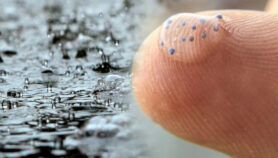By: Wagdy Sawahel
Send to a friend
The details you provide on this page will not be used to send unsolicited email, and will not be sold to a 3rd party. See privacy policy.
A novel approach to arsenic removal could lead to a quick and inexpensive purification of drinking water in developing countries.
Previous research demonstrated that arsenic can be removed from water using activated carbon or iron minerals, such as magnetite nanocrystals. However, such particles are too small to be effective in flowing water and they quickly degrade when exposed to the atmosphere, rendering them useless.
Now scientists have combined the nanocrystals with graphene-based materials to synthesise a new type of magnetite composite which increases adsorption sites for arsenic and makes the nanoparticles more stable in the environment.
"This graphene composite is shaken in water for ten minutes, immediately binding to arsenic, which can then be separated from water within a fraction of a minute using handheld magnets or filters," Kwang Kim, a scientist at South Korea-based Pohang University of Science and Technology who led this research told SciDev.Net.
"This inexpensive method, which anyone can use, is a very simple way to isolate arsenic ions from water," Kim said. "It shows nearly complete arsenic removal within one part per billion [the usual safety limit for arsenic in water is ten parts per billion], and could become a practical approach for arsenic separation from water."
In laboratory tests it took less than a minute to remove arsenic bound to the composite. Within an hour, almost all the poison was removed, leaving the water safe to drink, Kim said. Work is now underway to make industrial production of the composite economically viable.
Nan Pan, a nanotechnology researcher at the University of Science and Technology of China, based in Hefei, described the approach as "sound and most probably paving a new way to the heavy metal ion removal in water". But further studies into environmentally friendly production processes for the composite and into recycling it once it binds to arsenic are crucial before using it on a large scale, he said.
The safety of this technique also needs to be investigated and approved by relevant agencies before it can be widely used, James Tour, a mechanical engineer from the US-based Rice University, told SciDev.Net.
David Grimshaw, head of the international programme on new technologies at Practical Action — a UK-based charity that uses technology to challenge poverty — urged that "all toxicity test results are published so that the communities and other local organisations can make informed decisions about the adoption of this technique".
Vincent Casey, technical support manager at WaterAid, a UK-based non-governmental organisation that aims to improve access to safe water, hygiene and sanitation in the world’s poorest communities welcomed research into low-cost arsenic removal techniques and said that "the success [of this approach] will depend on all component parts being available at affordable rates on local markets".
The findings were published online in ACS Nano last month (16 June).
References
ACS Nano, doi: 10.1021/nn1008897 (2010)













